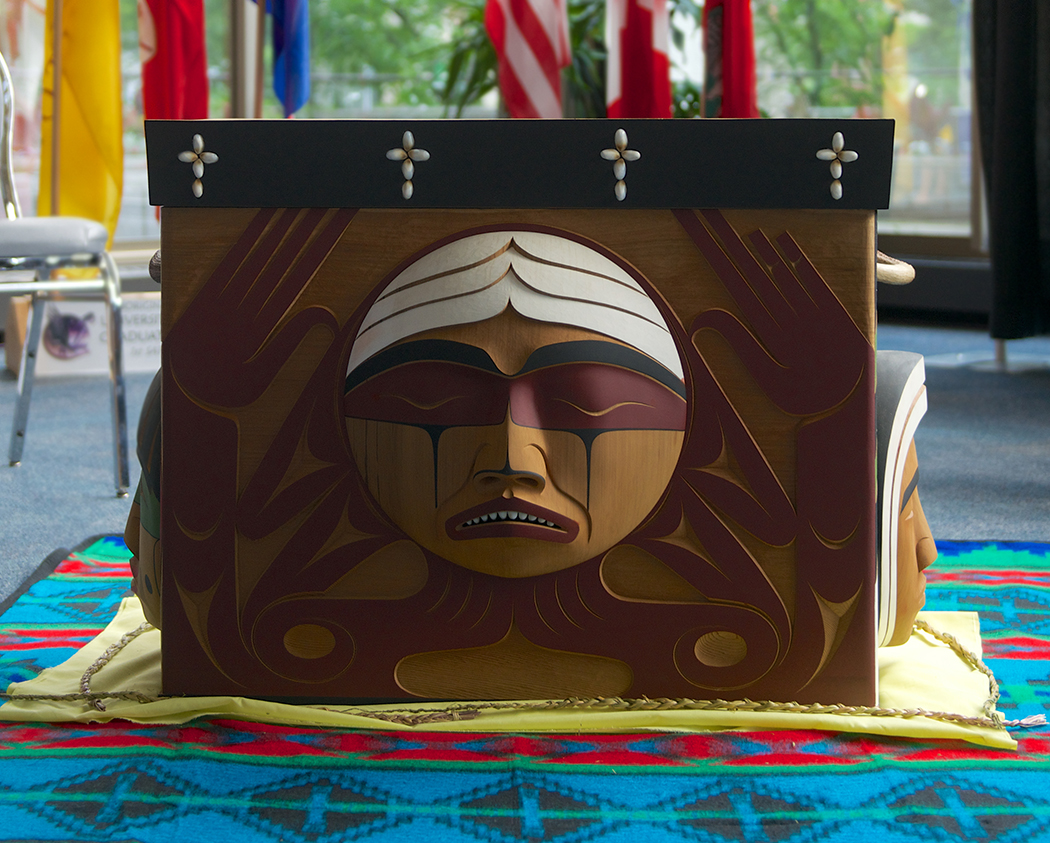
Carved by Coast Salish artist Luke Marston, the TRC Bentwood Box is a lasting tribute to all Indian Residential School Survivors. The box travelled with the TRC to all of its official events. // Photo by Adam Dolman
‘This history is not over’
Adele Perry, history professor and incoming vice-president of the Canadian Historical Association, wrote this column for the Winnipeg Free Press. It was originally published on June 9, 2015.
It has been a week since the Truth and Reconciliation Commission completed its six-year mandate and issued a 388-page summary of the final report. Canadian newspapers, radios, televisions and social media have been alive with discussion of residential schooling and what it means for understanding the past and the present. We are likely to still be talking when the TRC issues its expected six-volume final report later this year. Much of this conversation concerns history.
History is about the past, but it is written for and by people in the present, and it can’t be any other way. History is fundamentally about interpretation, about the sense we make of evidence left from times that have passed, the patterns we see, and the lessons we draw from them. It is a tricky business and often a harrowing one. But as discussion around the TRC makes clear, history and how it is used matters.
By any reckoning, the TRC summary is grounded in substantial amount of careful historical research. The TRC combed government and church archives for archival records of residential schools. In 2012 and 2013 the TRC went to court to secure access to records. The commission gathered almost 7,000 statements, 6,000 from residential school survivors and another 96 from former staff and their children. The TRC summary weights this evidence carefully, putting it in context to 30 years of serious scholarly and community inquiry into the history of residential schooling. The summary’s “History” chapter alone has 674 footnotes.
Critics uncomfortable with the TRC’s findings have responded with a revealing combination of colonial nostalgia and genuinely bad history. Conrad Black takes a break from a string of shopworn racist platitudes about European greatness to label the TRC’s cautious estimate that 6,000 children died in residential schools an “accusation.” In the Globe and Mail, Geoffrey Simpson finds all the focus on colonialism’s difficult history tiresome, an unhelpful “picking over” of a past he has no real interest in.
In these critiques the experience and perspectives of settlers are often given a disproportionate and revealing interpretative weight. In the last year, several non-indigenous writers have offered their own warm recollection of relatively brief stays spent in residential schools in the 1960s and ‘70s.
But surely settlers passing through late in the residential school era are in no way equivalent to the experience of 150,000 indigenous children who attended residential schools between 1883 and 1996, often for more than a decade.
Comments to call-in shows speak of residential school staff that meant well and tried hard, as if the good intentions of some non-indigenous people matter more than the oral and written archives that speak of an always difficult and often deeply violent system. Likewise these conversations often place disproportionate weight on the examples of indigenous people who enjoyed or benefited from their time in residential school.
History reminds us of the wide range of individual experience that people have of events — some people genuinely value their time as combatants in terrible wars. But we still find ways to acknowledge the absolute horror and large-scale loss these wars represented, and the need to mitigate the effects of them.
In some ways, the TRC summary report doesn’t ask for enough. But the TRC summary does demand we place indigenous peoples’ version of the history of residential schooling, and indeed Canada, at the centre rather than the margin of the history we tell.
It demands that we recognize the violence that underpinned the system. The TRC summary report asks us not to take false comfort in a few happy stories, but instead seriously examine the wide-scale patterns and structures. It makes clear that the intentions and experiences of non-indigenous individuals are not the main story to be told here. The report shows that the useful analogies are not to elite British boarding schools, but to other colonial contexts where child removal was state policy.
The TRC summary report also prompts us to realize the limits to what it has been able to document: the many schools they fell outside of its scope, the documents that were never made available and stories people would not or could not share. The claims here are cautious ones made with as much certainty as limited evidence produced in an era of poor Canadian record keeping. People who deny the history of residential schools really deny the history of Canadian colonialism.
This history isn’t over.
We see it in the staggering numbers of indigenous children in child welfare, in murdered and missing indigenous women, girls, and two-spirited people, in the over-representation of indigenous people in jails, in the relative prosperity of non-indigenous peoples.
This is our history, all of ours, and surely, it demands that we think seriously about it.






